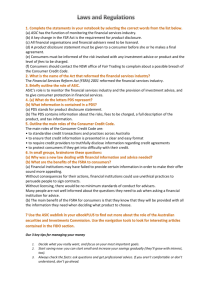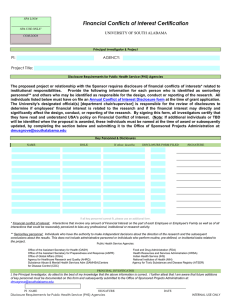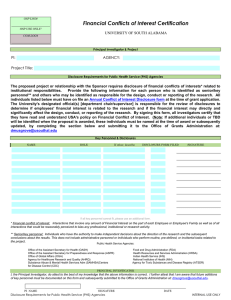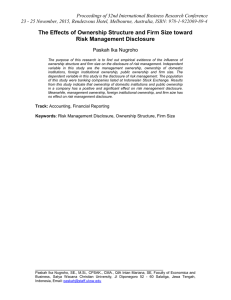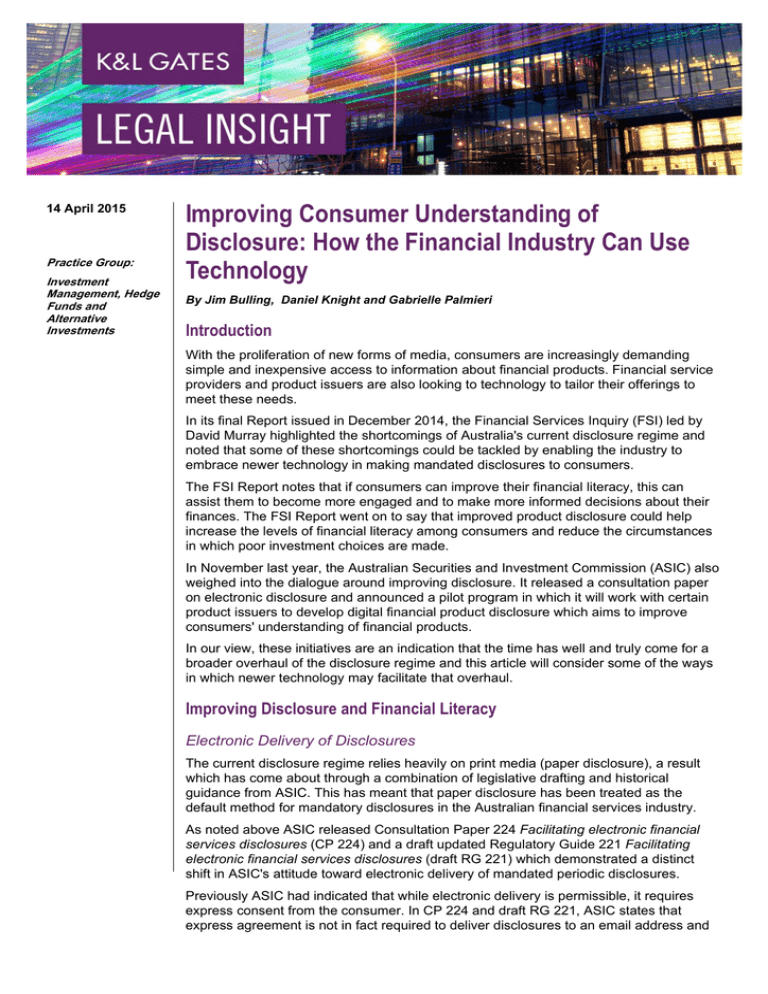
14 April 2015
Practice Group:
Investment
Management, Hedge
Funds and
Alternative
Investments
Improving Consumer Understanding of
Disclosure: How the Financial Industry Can Use
Technology
By Jim Bulling, Daniel Knight and Gabrielle Palmieri
Introduction
With the proliferation of new forms of media, consumers are increasingly demanding
simple and inexpensive access to information about financial products. Financial service
providers and product issuers are also looking to technology to tailor their offerings to
meet these needs.
In its final Report issued in December 2014, the Financial Services Inquiry (FSI) led by
David Murray highlighted the shortcomings of Australia's current disclosure regime and
noted that some of these shortcomings could be tackled by enabling the industry to
embrace newer technology in making mandated disclosures to consumers.
The FSI Report notes that if consumers can improve their financial literacy, this can
assist them to become more engaged and to make more informed decisions about their
finances. The FSI Report went on to say that improved product disclosure could help
increase the levels of financial literacy among consumers and reduce the circumstances
in which poor investment choices are made.
In November last year, the Australian Securities and Investment Commission (ASIC) also
weighed into the dialogue around improving disclosure. It released a consultation paper
on electronic disclosure and announced a pilot program in which it will work with certain
product issuers to develop digital financial product disclosure which aims to improve
consumers' understanding of financial products.
In our view, these initiatives are an indication that the time has well and truly come for a
broader overhaul of the disclosure regime and this article will consider some of the ways
in which newer technology may facilitate that overhaul.
Improving Disclosure and Financial Literacy
Electronic Delivery of Disclosures
The current disclosure regime relies heavily on print media (paper disclosure), a result
which has come about through a combination of legislative drafting and historical
guidance from ASIC. This has meant that paper disclosure has been treated as the
default method for mandatory disclosures in the Australian financial services industry.
As noted above ASIC released Consultation Paper 224 Facilitating electronic financial
services disclosures (CP 224) and a draft updated Regulatory Guide 221 Facilitating
electronic financial services disclosures (draft RG 221) which demonstrated a distinct
shift in ASIC's attitude toward electronic delivery of mandated periodic disclosures.
Previously ASIC had indicated that while electronic delivery is permissible, it requires
express consent from the consumer. In CP 224 and draft RG 221, ASIC states that
express agreement is not in fact required to deliver disclosures to an email address and
Improving Consumer Understanding of Disclosure: how the Financial
Industry can use Technology
that ASIC will provide relief so that express agreement is also not required in order to
make a disclosure available online. It is likely that this approach, if fully implemented, will
mean that over time electronic disclosure will replace paper disclosure as the default
method of delivery.
This is particularly sensible in an environment where more and more people are
spending time either working at their laptops or on their smart phones and tablets. The
increased accessibility technology offers is a development the industry should use to
enhance the meaningfulness of financial product disclosures and the efficiency with
which they are provided.
Innovative Point of Sale Disclosures
Over time, product disclosure statement (PDS) requirements have become fragmented
with substantially different requirements applying to different types of products in a
manner that is not necessarily logical.
For example, there is a 'shorter PDS' regime (a mandated length of 8 pages) for
superannuation and simple managed investment schemes and a full PDS regime for
other products. For both types of PDS, information which would otherwise need to be
included can be contained in a separate document which is incorporated by a reference
to it in the PDS. This means that in order to obtain all the information which is relevant to
the product, consumers may be required to look at multiple documents prepared by the
product issuer. Full PDSs and material referenced by incorporation frequently run to over
100 pages and may contain additional information which is not strictly required.
In addition to the inconsistent format requirements, there are inconsistent content
requirements for different types of product, including in some cases 'Benchmarks',
'Disclosure Principles' and 'Good Disclosure Principles'. This increases complexity for
both product issuers in preparing disclosures and consumers in interpreting and
comparing them.
In CP 224 and draft RG 221, ASIC, in looking at ways to enhance financial literacy,
examines whether disclosures given electronically could incorporate a range of media
such as video, audio and interactive presentations. While acknowledging that there are
some legal barriers, ASIC encourages the use of innovative PDSs, which incorporate
these features. If such technologies can be used to assist consumers with assessing
their financial needs and investigating which financial products may be suitable, this
would be beneficial to both financial service providers and consumers.
One of the barriers to the use of interactive PDSs identified by ASIC is the current
prescriptive nature of regulatory requirements associated with disclosure documents. For
example, the shorter PDS regime mandates a particular length and there are
requirements regarding the placement of particular content. ASIC has also identified a
perception within the industry that there cannot be more than one version of a PDS
provided (such as a print copy which looks different to the interactive version). To
address some of these barriers, ASIC proposes to provide class order relief, a draft of
which has not yet been released.
The use of appropriate technology could potentially do away with the need for PDSs
altogether, relieving the burden on product issuers and engaging consumers in a way
that enables them to actually understand and use the information being provided.
Another initiative of ASIC's was addressed in its Report 391 ASIC's deregulatory
initiatives (issued May 2014), in which ASIC discussed a proposal to enable issuers of
simple managed investment schemes to provide consumers with a key fact sheet (which
2
Improving Consumer Understanding of Disclosure: how the Financial
Industry can use Technology
would contain prescribed content) and a self assessment tool. As part of the proposal,
product issuers would not be required to issue a PDS.
As noted above, ASIC is looking at a pilot project to develop these tools and promote
digital disclosure including testing the tools with consumers.
At this time it seems the proposal only extends to simple managed investment schemes,
however depending on the outcomes of the pilot project, it may be something that
eventually is extended to other financial products in the future.
Conclusion
It is widely understood that the existing disclosure regime in Australia is not fully
delivering on some of its key objectives. An environment of outdated methods of delivery
and at times lengthy and disjointed disclosure has limited progress in improving the
financial literacy of consumers, leaving them at increased risk of investing in unsuitable
products.
Paper documents can fail to engage consumers who are becoming increasingly used to
obtaining information and transacting online. The historical barriers to electronic
disclosure in the financial services industry continue to restrain development in this area.
Product issuers are responsible for producing and delivering disclosure documents which
comply with a complex regulatory regime which is undeniably costly and inefficient.
Technological advancements and a fresh approach by regulators are on the horizon.
ASIC is already taking steps to remove barriers to electronic disclosure and is
encouraging the industry to embrace more innovative means of disclosure and consumer
interaction. With more assistance from the legislators product issuers should be able to
be use technology more effectively enhance financial literacy and the decision making of
consumers regarding investment in financial products.
3
Improving Consumer Understanding of Disclosure: how the Financial
Industry can use Technology
Authors:
Jim Bulling
Daniel Knight
jim.bulling@klgates.com
+61.3.9460.4338
daniel.knight@klgates.com
+61.3.9460.4324
Gabrielle Palmieri
gabrielle.palmieri@klgates.com
+61.3.9205.2086
Anchorage Austin Beijing Berlin Boston Brisbane Brussels Charleston Charlotte Chicago Dallas Doha Dubai Fort Worth Frankfurt
Harrisburg Hong Kong Houston London Los Angeles Melbourne Miami Milan Moscow Newark New York Orange County Palo Alto
Paris Perth Pittsburgh Portland Raleigh Research Triangle Park San Francisco São Paulo Seattle Seoul Shanghai Singapore
Spokane Sydney Taipei Tokyo Warsaw Washington, D.C. Wilmington
K&L Gates comprises more than 2,000 lawyers globally who practice in fully integrated offices located on five
continents. The firm represents leading multinational corporations, growth and middle-market companies,
capital markets participants and entrepreneurs in every major industry group as well as public sector entities,
educational institutions, philanthropic organizations and individuals. For more information about K&L Gates or
its locations, practices and registrations, visit www.klgates.com.
This publication is for informational purposes and does not contain or convey legal advice. The information herein should not be used or relied upon
in regard to any particular facts or circumstances without first consulting a lawyer.
© 2015 K&L Gates LLP. All Rights Reserved.
4

